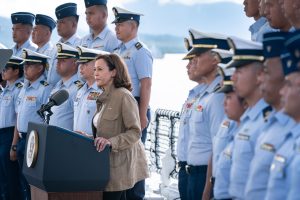U.S. Vice President Kamala Harris landed in Manila last week, a visit which was meant to send a signal to the Philippines that they can count on the United States for economic and defense assistance. Along with reaffirming defense ties, Harris announced a raft of economic agreements covering energy, telecommunications, and nickel mining. Amid rising geopolitical tensions with China, the visit also sent a larger message that the United States may be getting more serious about expanding its strategic footprint in Southeast Asia by appealing to the economic interests of key regional allies.
November was a whirlwind month of summits for Southeast Asia, with the region hosting dignitaries and heavy hitters from around the globe at the G-20 in Bali, the ASEAN annual gathering in Phnom Penh and the APEC summit in Bangkok. One of the overriding messages emanating from the region, reinforced again and again at the summits, was that countries in Southeast Asia want to focus not on geopolitical tensions between great powers, but on their own economic agendas and development goals. As the economic profile of the region grows, the question is less about picking a side, and more about ASEAN countries asking dueling global rivals like China and the U.S.: what can you offer us?
For the last several years, a strong case could be made that China has been quicker on the draw with an answer. Through the Belt and Road Initiative, as well as via other channels, China has increased its direct economic engagement with Southeast Asia at a faster clip than the United States, particularly in strategic sectors like telecommunications and transportation. A few examples of such engagement include the Jakarta-Bandung high-speed rail line nearing completion in Indonesia; a first-of-its-kind metro line recently opened in Hanoi; and Chinese investment activity in the Philippine and Indonesian telecom sectors.
The initiatives unveiled by Vice President Harris in Manila could be interpreted as a U.S. response to this Chinese activity, as they cover many of the same sectors, especially energy and telecom. As reported by Rappler, Harris indicated the U.S. was “eyeing a partnership with NOW Telecom for the deployment of 5G technologies in the Philippines” and that the U.S. Department of Energy would partner with the Philippines to develop new forms of energy production, including renewable energy. There was even mention of civil nuclear cooperation.
But perhaps the most interesting development from Harris’ trip was the announcement that the U.S. would be investing in the Philippines’ downstream nickel and cobalt processing industry. Nickel is an essential input in the manufacture of lithium-ion batteries and is expected to be in high demand as global clean energy transitions gather steam in coming years.
Indonesia, which has the world’s largest raw nickel ore deposits, has been using export bans on unprocessed ore to increase investment in its downstream industries. This has, by and large, worked and resulted in significant investment (particularly from China) in industrial parks in Sulawesi, which are likely to be very important links in the next generation of clean energy supply chains.
The country with the world’s second-largest supply of nickel ore? That would be the Philippines. American plans to invest in the Philippines’ downstream nickel industry would suggest they have caught on to the importance of nickel in clean energy supply chains, and the strategic necessity of ensuring American companies have access to it.
At this point, the initiatives Harris announced last week are just laying the groundwork; they send a signal to the Philippines about the readiness of the United States to step up economic engagement in strategic sectors like energy, telecom, and nickel, sectors where China has so far been more active regionally. We will have to wait and see the extent to which these initiatives are actually translated into reality. It is also unclear whether this approach is likely to be extended beyond the Philippines, which already has a uniquely deep relationship with the United States.
But simply sending the message is important, because it says that the United States may no longer be content to sit back and expect a rules-based global system of free trade and the normative appeal of American values to do the heavy lifting in the region. Instead, the administration is actively targeting strategic sectors, and coming to the table with concrete plans about what it can offer potential partners and allies.

































